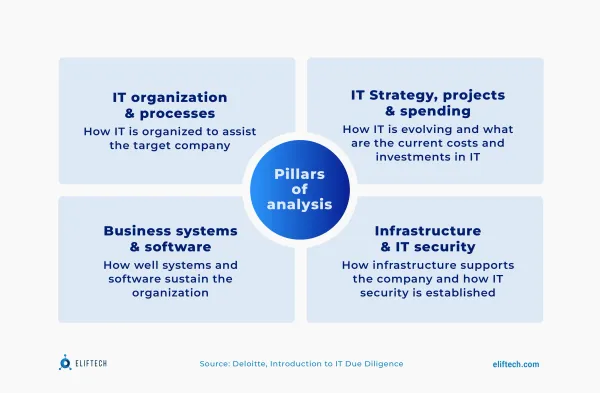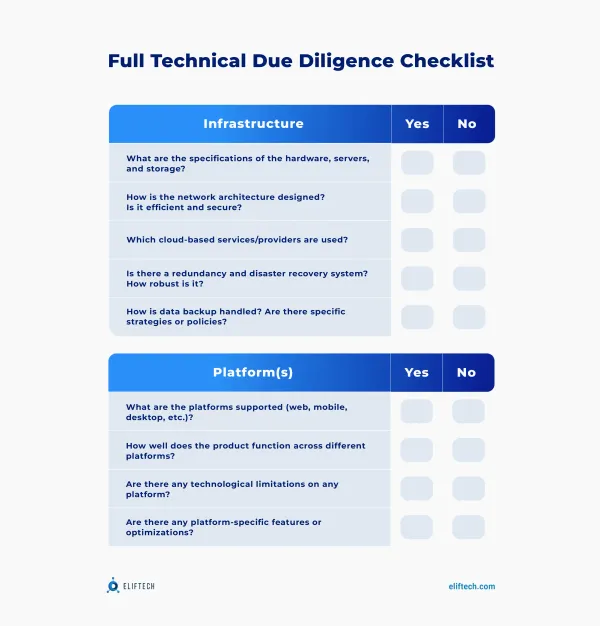

Yuliia Zhuravlova
With an amplified pace in tech acquisitions and investments, more than ever, the arena has highlighted the indispensability of rigorous technical due diligence. According to CB Insights, about 70% of upstart tech companies fail — usually around 20 months after first raising financing. The central factor behind these failures? Oftentimes, it's not paying enough attention to the critical underpinnings of a tech venture, something that technical due diligence can intercept.
This article provides an immersive foray into the world of software technical due diligence. We delve deeper into its dynamics, unlocking its meaning, charting out the process, and laying down an elaborate checklist for your guidance. The aim? To empower startup founders and tech hopefuls with the know-how to create a robust technological platform that can stand up to rigorous evaluation processes and also lay the foundation for sustainable growth and agility in your operations. So let's jump right in and start uncovering the intricacies of tech due diligence.
As a startup founder who has poured time and resources into a project, your worst nightmare is finding out you've overlooked critical technical information that jeopardizes the success and longevity of your venture. Scary, right? Even worse is that according to Harvard Business Review, 62% of mergers and acquisitions fail to achieve their financial objectives, with subpar due diligence being one of the primary reasons for failure.
Tech due diligence is your safety net in such situations. It serves as a comprehensive audit that assesses your startup's technological infrastructure, processes, applications, and capabilities.

The primary reason to conduct tech due diligence is to uncover and evaluate potential risks and figure out how they might impact the business venture. It provides valuable insights and churns out an unbiased evaluation of a company's technical operations.
The evaluation usually includes:
Carrying out technical due diligence can prevent significant losses by identifying critical flaws or hidden bottlenecks before the partnership or investment fully materializes. For instance, McKinsey & Company found that companies that carry out due diligence on their target's technology are 2.8 times more likely to achieve a successful outcome than those that don't.
Technical due diligence becomes necessary in several scenarios. Some of these include:
Tech due diligence is typically conducted by a group of technical experts or a third-party firm specializing in technical audits. The evaluators are usually experienced tech veterans in areas such as coding, software architecture, system infrastructure, and cybersecurity. They meticulously examine every aspect of the company's technological standing – from code quality and data security to system architecture and scalability.
As a third-party vendor, our role here is to conduct tech due diligence by utilizing their team's extensive expertise in various technical domains. Our team assesses a company's technological capacities and provides recommendations to address identified gaps or weaknesses, ensuring that the venture is primed for success and future growth.
Navigating the realm of technical due diligence (TDD) can indeed be precarious, especially for startups. Despite having promising ideas and the enthusiasm to match, some startups stumble in this critical area. Here are some key reasons why these budding enterprises might falter during the tech due diligence process.
As startups hustle to build their products and bring them to market quickly, comprehensive technical documentation often takes a back seat. However, in TDD, the lack of proper documentation is a glaring red flag. It raises questions about the sustainability of the technology, its maintenance procedures, and its ability to scale or be integrated with other systems.
Startups, understandably, focus on making their ideas work in the short-term often neglecting to future-proof their technology. But TDD requires a long-term vision, assessing whether the infrastructure can scale as the company grows or adapt to industry shifts. A failure to demonstrate this adaptability and scalability could be fatal.
In the rush to the market, corners may be cut in the coding process resulting in 'quick and dirty' code. However, poor quality code, lack of consistent coding standards, or extensive technical debt can lead to significant concerns about future maintenance costs and can be a chief reason for failing TDD.
Cybersecurity is an essential aspect of any tech-based venture. Startups sometimes underestimate this need, putting them in a vulnerable position. Insufficient security measures or lack of compliance with standard security practices can severely hold back startups in the TDD process.
Startups often lean heavily on a few key individuals for their technological needs. However, if these skills aren't transferable, or expertise isn't spread across the team, it creates a risk that can scare off potential investors. This over-reliance on a few can indeed make or break a startup in technical due diligence.
While technology forms the core, non-technical aspects like user experience, market timing, or customer feedback play an undeniable role in a product’s success. Overlooking these in favor of tech aspects can fail to demonstrate a holistic understanding of the business, often leading to TDD failures.
Startups, especially those on a tight budget, might hire junior developers to develop their product. This decision can lead to issues such as insufficient code quality and poor development practices, which are detected during technical due diligence. As a result, potential investors may question the company's technological capabilities and competence.
In this case, a thorough audit of the startup's software must be conducted as soon as possible, identifying areas of insufficient code quality or poor development practices.
Successful technical due diligence isn't completed overnight. It's an ongoing process that requires thoroughness and attention to detail. As a software development team, we've been involved in various facets of the technical due diligence process. For some clients, we've filled the role of independent technical evaluators, systematically auditing and assessing a product's codebase to identify strengths and weaknesses before embarking on a full-fledged due diligence process. Each engagement, regardless of the specifics, reinforces our objective: to ensure a product's technical robustness and potential for future growth.
Here's what the breakdown of this process generally looks like:
Pre-assessment
Before diving into detailed evaluations or audits, the initial stage begins with understanding the existing technical landscape. This involves a thorough knowledge gathering process about the company's product(s), technology stack, market position, and competition. It sets the context for later stages, providing a comprehensive overview that will be instrumental in guiding the due diligence process. This stage should equip the evaluating team with a fundamental understanding of what the startup's technology is, what it does, and how it does it.
Code review and architecture evaluation
We proceed to conduct thorough code reviews and architecture evaluations following the pre-assessment. This stage comprises careful inspections of the code quality, codebase organization, and the technology stack. Architectural decisions, scalability, maintainability, reliability, and security practices are also scrutinized. This stage provides insights into the product's technological health and scalability.
On-site technical inspection
An in-depth exploration of the startup's tech ecosystem is essential after preliminary checks. This often involves on-site visits, though remote evaluations have become increasingly prevalent in the digital age. Our technical specialists scrutinize various elements such as system architecture, codebase, security measures, and deployment and testing routines. The objective here is to ensure the startup's technology aligns with industry best practices and can withstand the rapidly changing tech landscape.
Analyzing technical documentation
A poorly documented tech venture may end up being part of the 62% of mergers and acquisitions that fail to achieve their financial objectives due to underperformance in due diligence. Thus, our next in line is the examination of all technical documentation. This includes the study of system architecture designs, test plans, product specifications, user manuals, and relevant intellectual property rights.
Evaluating development practices and processes
We assess the startup's development practices and processes, including development methodologies (Agile vs Waterfall), project management tools, version control systems, and code review routines. Critical performance indicators are also monitored. The objective is to ensure the startup's development processes are consistent, reliable, and agile to adapt to future needs and challenges.
Tech stack market alignment
The final step ensures that the technology stack aligns with industry trends and standards. The product's adaptability to technological changes is reviewed, and we confirm whether the technical choices the startup made are future-proof and capable of handling potential growth and expansion.
Companies preparing for due diligence may often wonder about the areas in focus. To offer a glimpse into methodology and areas of focus, we have prepared a detailed technical due diligence checklist. It can be broadly divided into the following areas of interest: infrastructure, platforms, software architecture, coding standards & quality, security measures, dependencies, scalability, operational processes, and team capabilities & structure.
Every one of these components sheds light on different facets of a company's technological standpoint.
Infrastructure is akin to the company's digital groundwork. It forms the backbone that holds the rest of the tech operations. Analyzing it gives insight into the robustness, reliability, and scalability of the deployed technology. Details like network architecture, cloud service providers, data backup strategies, and disaster recovery systems, while mentioned in the checklist, reveal the overall resiliency of the digital structure.
Tip: Look for a network architect with experience in cloud services and disaster recovery systems to help establish and demonstrate the strength and resilience of your digital infrastructure.
The platforms represent where the product is in use – web, mobile, and desktop applications. Turning an analytical eye toward the potential limitations, technological adaptability, and platform-specific features can indicate the efficiency of the product or service. It also offers insight into the feasibility of future expansion across different technologies and platforms.
Tip: Engage a platform-specific developer or consultant to ensure efficiency in platform-specific features and enable future expansion across different technologies and platforms.
Examining the software architecture can offer a wide-lens view of the system's design and flexibility, as well as its maintainability – factors that play a pivotal role in accommodating future changes or integrations, thus adding value to businesses in the long run.
Tip: Engage a software architect who can assess and improve the system's design, flexibility, and maintainability to ensure long-term value for the business.
Quality plays a paramount role in code development. By looking at code readability, modularity, reusability, and conformity to coding practices, we can gain a sense of the software's overall health and maintainability. High technical debt or poor code quality could imply significant future costs to rectify issues and keep the software running efficiently.
Tip: Consider bringing in a senior developer or code expert to review and enhance the code quality, reducing technical debt, and improving overall software health.
In an age of digital threats, understanding and gauging cyber-security measures form a critical part of due diligence. Assessing security protocols helps to expose potential vulnerabilities, thereby preventing future compromises and breaches, securing user trust, and protecting the company's reputation.
Tip: Engage a cybersecurity expert to assess security protocols, identify vulnerabilities, and implement improvements to protect the company's reputation and secure user trust.
Inspecting dependencies, including third-party libraries, services, and APIs uncovers any licensing compliance concerns, giving an insight into the associated risk. Furthermore, it can also provide a view towards the feasibility and long-term impact of integrating the technology within an existing tech stack.
Tip: Consult a software licensing expert to verify compliance related to third-party libraries, services, and APIs, minimizing the associated risks.
The scalability of a system is a crucial factor in determining its potential for growth and its resilience in the face of increased demand. Evaluating systems' load management and how efficiently data growth is managed can assist in verifying whether the technology can withstand and flourish under future developments.
Tip: Involve a performance engineer or expert in scaling systems to ensure the technology can withstand increased demand and accommodate future growth.
Operational processes provide insight into the practical, day-to-day running of a business's digital end. By examining the deployment, release processes, error logging, and resolution procedures, we can uncover areas of inefficiency or potential difficulty, influencing future productivity and revenue.
The team's capabilities directly impact the performance and sustainability of the tech stack. A skilled and knowledgeable team bestows the company with a competitive edge, agility, and propensity to meet current and future tech demands.
Tip: Seek the help of a DevOps expert or process consultant to analyze and streamline deployment, release processes, error logging, and resolution procedures.

To have this information easily accessible and convenient, download our Tech Due Diligence Checklist to guide you through the process. It will guide you meticulously through these areas, and you'll have it readily accessible when you need it.
Getting ready for a technical due diligence audit is no small feat. It's like preparing for a marathon where you need to be in top shape from start to finish. Acoording to PitchBook, a whopping 70% of private equity firms conduct a thorough due diligence process before deciding to invest, so it's crucial to excel in this test to attract big-league investments.
So, to sum up, what exactly should a company focus on during tech due diligence preparation?
The final and crucial step:
Not all companies possess the expertise required for a rigorous audit. If your current team is short on tech talent or stretched thin, it may prove valuable to enlist an external consulting team. They can provide the necessary in-depth knowledge and expertise to optimize your project and increase your chances of successful tech due diligence.
At the end of the day, the target is not just to survive the due diligence process but to emerge successfully with a strengthened technological platform ready for sustainable and agile growth.